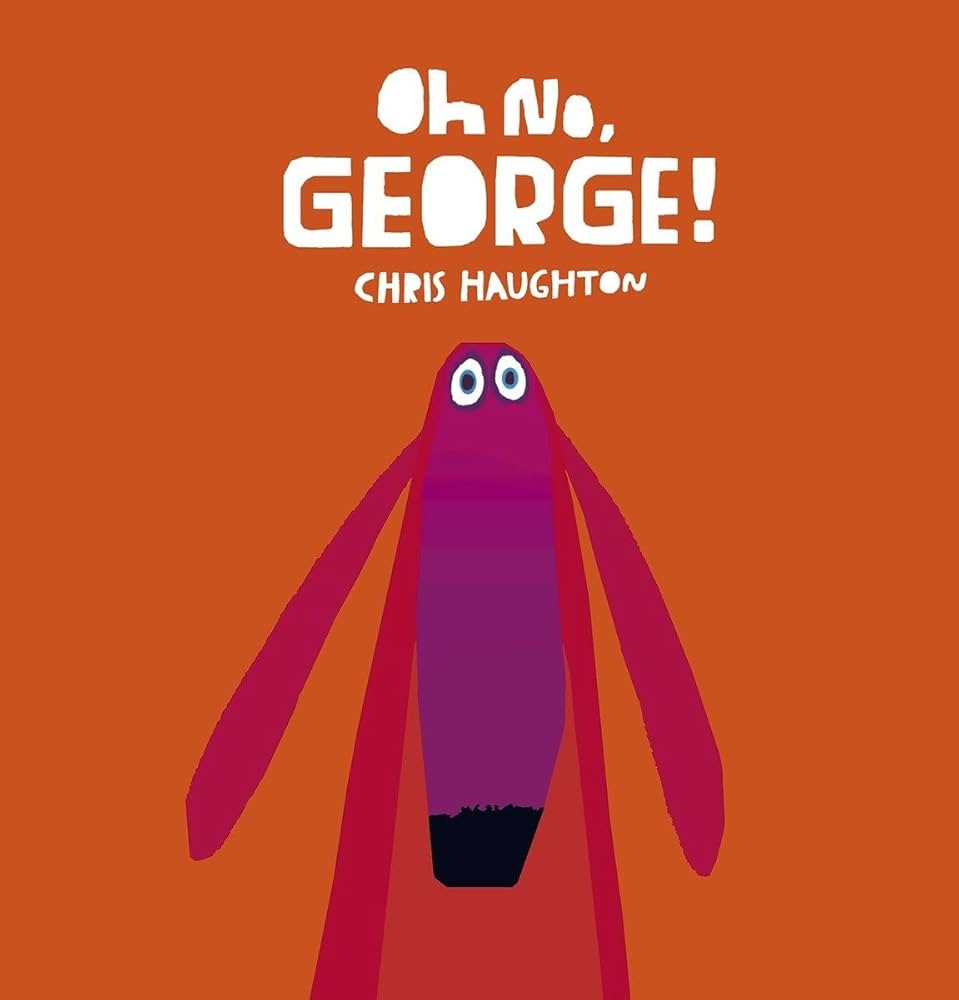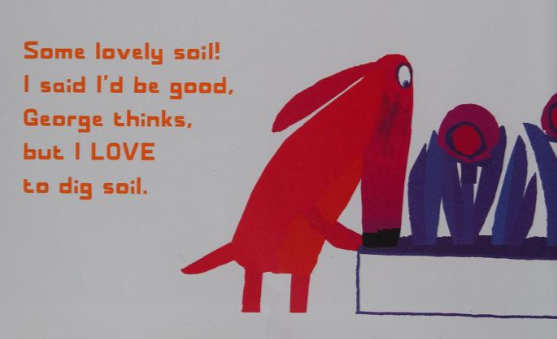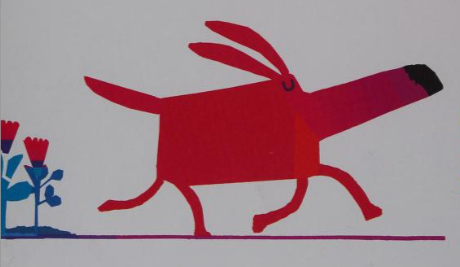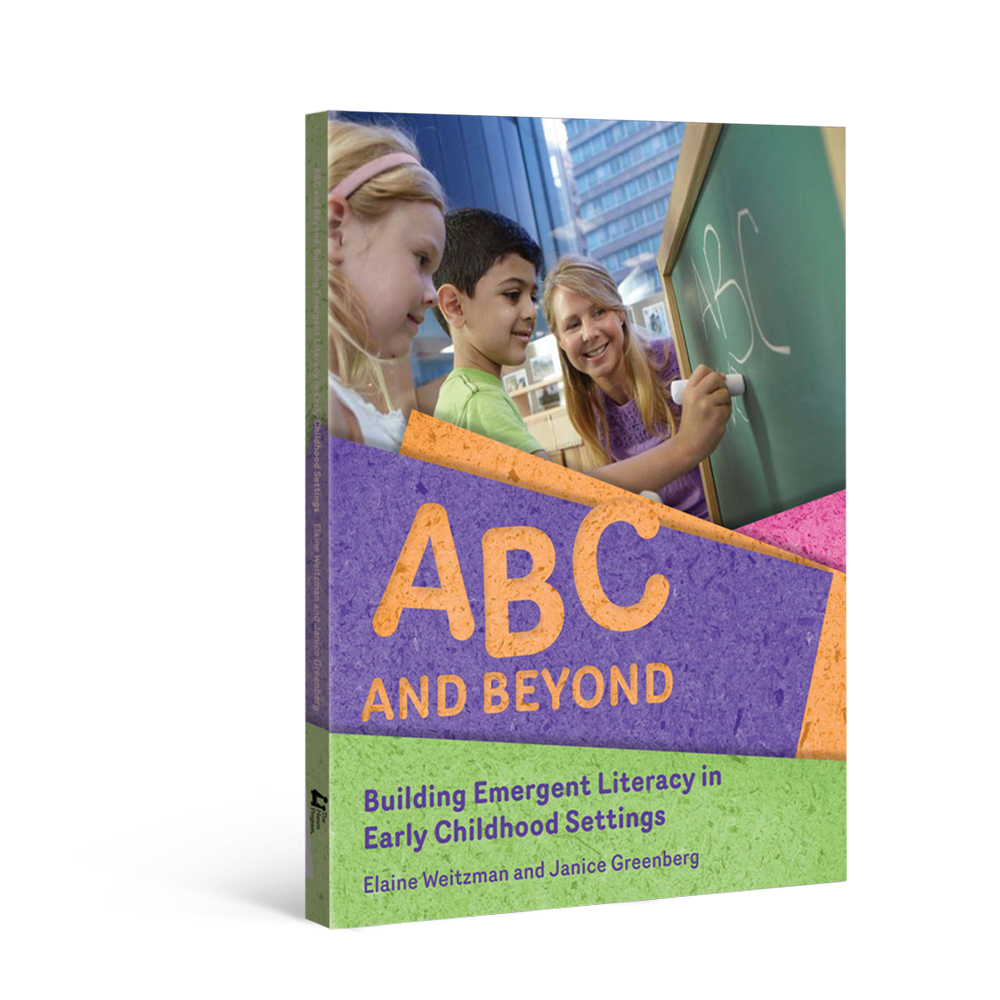This month's Book Nook topic is...
Turn Reading into a Conversation
with Oh No, GEORGE!

Children benefit most when adults read with them, rather than to them. What’s the distinction? Reading with children means having a back-and-forth conversation during the story. It gives children space to talk about what interests them, ask questions, and share their ideas. When adults pause to listen and respond, it helps children connect the story to their own lives, build vocabulary, and strengthen the thinking and language skills that support reading comprehension.
The Book:
Oh No, GEORGE! By Chris Haughton
Why we chose this book
This book is funny and entertaining for children and adults alike. It is a humorous tale about a dog named George who tries very hard to do what he is told but faces temptation at every turn. This relatable story has so much for you and the child to talk about as you turn book reading into a conversation.
Get the Conversation Started
The first step in turning book-reading into a conversation is to Observe, Wait and ListenTM (OWL™). This means finding times to wait, without talking, while you observe the child to see what interests them about the story. They may smile, point or say something about the story. This is an important strategy because it helps you find out what the child is interested in, making it easier to encourage conversation. Some good times to wait during book reading are:
- Before or after you turn the page
- After you make a comment about the story
- After you point to and comment on an illustration
- When something exciting happens in the book
- After you ask a question
Once the child has shown you what interests them, Follow the Child’s Lead by responding with a related comment. For example, if the child points to the picture of George on the book’s cover, you might say “That is George the dog. He looks like a cute dog!” After you comment, wait to see what the child says or does.
Keep the Conversation Going
Try to keep the conversation going back and forth by using a balance of comments and questions related to the child’s interests. Ideally, you’ll be able to keep the conversation going until you’ve each taken two or three turns.
How much conversation you have with a child during book reading depends on whether it’s the first time you're reading the book together. During a first reading, children are focused on understanding the story, the characters, and what’s happening—so too much interruption can disrupt their comprehension. For this reason, it’s best to keep conversations short, and keep the story moving when reading it for the first time.
Re-reading the same book once a child is more familiar with the plot, creates opportunities for deeper conversation, predictions, and connections to their own experiences. There are many different directions the conversation could take, but here are a few examples of what you could talk about while reading Oh No George!
Make Predictions
Making predictions about what might happen is a great way to build back-and-forth conversations and encourage children to draw on their knowledge, experience and reasoning skills to deepen their understanding of a story.
 This story has many opportunities to make predictions about what George will do. For example – George’s owner asks George to “be good” while he is out. George is doing his best to behave but his willpower is tested many times. Like when he sees a flower garden filled with soil and that he really wants to dig in. When George faces this temptation, you can ask “What do you think George will do?” Wait to give the child a chance to continue the conversation. After the child responds, you can make a prediction of your own, like, “I think George will dig in the soil and make a big mess!”
This story has many opportunities to make predictions about what George will do. For example – George’s owner asks George to “be good” while he is out. George is doing his best to behave but his willpower is tested many times. Like when he sees a flower garden filled with soil and that he really wants to dig in. When George faces this temptation, you can ask “What do you think George will do?” Wait to give the child a chance to continue the conversation. After the child responds, you can make a prediction of your own, like, “I think George will dig in the soil and make a big mess!”
Talk about emotions
Recognizing how others are feeling is an important part of understanding stories. This book has many opportunities to talk about emotions. During the story, George feels:
- delighted
- sad
- happy
- proud
 For example, at the end of the story, George goes for a walk with his owner and this time his willpower is strong. As he walks past the soil, he holds his head high and resists temptation. If the child points to George, you could say “George feels proud because he didn’t dig in the soil this time, even though he really wanted to.”
For example, at the end of the story, George goes for a walk with his owner and this time his willpower is strong. As he walks past the soil, he holds his head high and resists temptation. If the child points to George, you could say “George feels proud because he didn’t dig in the soil this time, even though he really wanted to.”
Talk About the Child’s Experiences
Relating what’s happening in the book to a child’s existing knowledge and experiences is a great way to build their understanding of the story and keep the conversation going.
With this book, you could ask the child, “Have you ever done something you knew you shouldn’t – but couldn’t help yourself? How did you feel?” If the child has a pet dog you could ask “Can you think of some times when your dog did something he knew he shouldn’t do? What did you do?” Listen to the child’s experiences and share some of your own! You could say “I remember that time I knew I shouldn’t have another piece of chocolate cake, but I did anyway and then I had a stomach-ache.” Keep the conversation going for several turns by commenting and asking questions that invite the child to contribute. Remember to wait (up to 10 seconds!) after making a comment or asking a question. Waiting gives the child time to think and respond with a comment of their own.
Read the book again (and again!)
Children enjoy reading the same book many times. As they become familiar with the story, you may find that the conversation continues to grow as the child shares new ideas or perspectives about the story. Turning book-reading into an enjoyable, back-and-forth interaction lays the foundation for strong literacy and language skills.
Happy reading!
More Resources
The strategies in this Book Nook post are drawn from Hanen’s practical, research-based guidebooks for building emergent literacy. Explore the links below to learn more about how these guidebooks can support you.
For Parents I'm Ready! guidebook
I'm Ready! guidebook
For Educators ABC and Beyond guidebook
ABC and Beyond guidebook
